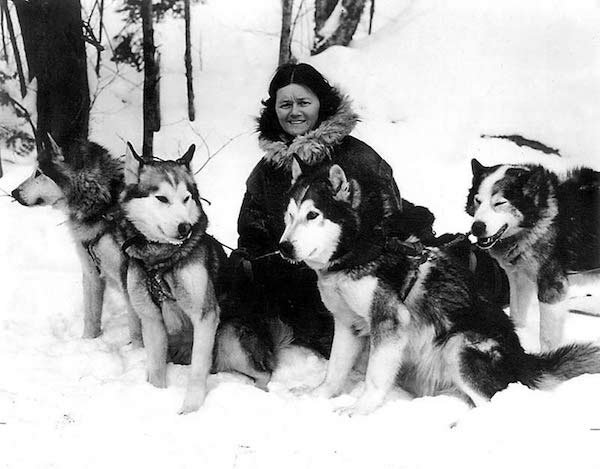
It can confuse a “newbie” just getting into dogs to read about bloodlines, lines, or strains, and wonder what the difference is between them, but they are essentially the same thing: All refer to a type within a breed that has been developed by an individual from a specific kennel. We need not look further than the Alaskan Malamute in which the Kotzebue, Hinman, and M’Loot lines explain this, but each was important to the breed.
The Malamute as we know it today is credited to Arthur T. Walden, but other individuals also played big parts, and in this post, we focus on Eva “Short” Seeley.
Back in 1923, Eva was a young teacher who chanced upon a newspaper article about a winter festival in Gorham, NH at which Arthur Treadwell Walden’s Chinook dog sled team would be appearing. Eva felt sure that a sled team would be a big hit at her own local carnival, so she arranged for two teams to appear there, and one of them was Arthur Walden’s.
Part of the attraction of having a sled team appear was the chance to ride on one, and Eva took advantage of the opportunity. She ended up on Walden’s sled, and as they slid over a snow covered golf course, the lead dog saw a cat and off the team went flying! When Walden was forced to overturn the sled to stop the team, he injured his hand, but Eva was absolutely thrilled to pieces. The bug was planted, as was the beginning of her professional relationship with Walden. She and her husband, Milton, became regular visitors to Walden’s kennel, and in time, the couple would take over the kennels. They were now part of the mushing world.
It was in this world that Eva met a large freighting Alaskan Malamute named, “Rowdy of Nome.” Eva was smitten and sought out more like him – dogs usually found in the Norton Sound area of Alaska.
Enter “YukonJad,“or “Jad” as he was known. Jad had been given to musher, Leonhard Seppala, who was more interested in Siberian Huskies than he was in a slower freighting-type dog like “Jad.” Some sources say Seppala gifted Jad to Eva, others suggest that Eva bought the dog, but what is relevant is that Rowdy and Jad were the prototypes of the dogs the Seeleys wanted to breed: Large, heavy boned, and strong with plume tails and erect, low set ears. Rowdy and Jad were the first of what would come to be known as the Kotzebue line of Alaskan Malamutes. Dogs in this line had consistent type and size, good heads, good muzzles, and a wonderful expression. Many felt that a good “Kotzebue” bred into any line would improve it.
Little did Eva know back then that she would be responsible for getting AKC recognition for the breed. All Eva had originally wanted was to have her Kotzebue line declared an official breed, but the AKC required her to prove that the breed actually existed, that there were sufficient enough dogs with a uniform appearance to represent the breed, and that there were enough of them to guarantee that the breed could move forward.
Eva rounded up a two-generation signed pedigree from Jad’s original owner, Frank Gough, stating that Jad was, indeed, an Alaskan Malamute. She also gathered other breeders who started to show their dogs at dog shows. In 1935, the AKC recognized the breed and granted registration to Alaskan Malamutes who had a minimum of a two generation pedigree. Rowdy of Nome became the first Malamute to be registered. It was Jad, however, who had sired the first litter of “modern” Alaskan Malamutes in 1929. One of those pups, Gripp of Yukon, became the first AKC Alaskan Malamute show champion. Later, when the Alaskan Malamute Club of America was formed in 1953, Eva became its first President,
We should mention that not everyone held Eva Seeley in high regard. We came across a source that painted an unflattering picture of her as a political, controlling individual ruthless in her dealings with other dog people. As Eva died in 1985, she cannot address the charges, but there’s no taking away from what she accomplished. The Kotzebue line was the only strain of the breed to receive early AKC recognition. There were other lines that we’ll discuss in subsequent posts, the Hinman line and the M’Loot line.
Image: Eva “Short” Seely with four of her Alaskan Malamutes circa mid-1930s, photo attributed to the AKC

Eva Seeley’s first sled dog was Nook, the son of Chinook (progenitor of the Chinook breed we have today) and a GSD. We have tracked the pedigrees of every Chinook ever born and Nook is part of our database. Were it not for an argument over money between Seeleys and Arthur Walden, Eva might have continued to be involved with the breed. Her Chinook Kennel name originally belonged to Walden. The history of the Malamute, Chinook, and the Siberian (via Seppala) are very intertwined.
We definitely got that impression, Ginger. Aone of these breeds are our own, we thought it best to stick to one breed at a time and hope that someone just like you would weigh in, so thank you! Eva never really got “into” the Chinook the way she did the Malamute, did she?
I find the intersection of the Chinook and the Mal lines just fascinating! I wonder if these great pioneers had any imagination what all would come of their work with these foundational dogs! I’m such a geek for #doghistory!
I met Eva in the early 80’s in Vancouver, I had Tote Um line dogs, bred by Oopik Kennels out of Manitoba, and had spent a few winters sledding and summers showing my dogs at CKC shows. She was amazing, very friendly and we chatted at her home for several hours. She was very down to earth, and her joy in sharing was very evident <3